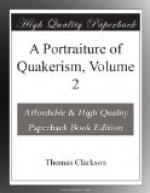George Fox suggested many regulations on this subject. He advised, among other things, when persons had it in contemplation to marry, that they should lay their intention before the monthly meetings, both of the men and women. He advised also, that the consent of their parents should be previously obtained, and certified to these. Thus he laid the foundation for greater harmony in the approaching union. He advised again, that an inquiry should be made, if the parties were clear of engagements or promises of marriage to others, and, if they were not, that they should be hindered from proceeding. Thus, he cut off some of the causes of the interruption of connubial happiness, by preventing uneasy reflections, or suits at law, after the union had taken place. He advised also, in the case of second marriages, that any offspring resulting from the former, should have their due rights and a proper provision secured to them, before they were allowed to be solemnized. Thus he gave a greater chance for happiness, by preventing mercenary motives from becoming the causes of the union of husbands and wives.
But George Fox, as he introduced these and other salutary regulations on the subject of Marriage, so he introduced a new manner of the celebration of it. He protested against the manner of the world, that is, against the formal prayers and exhortations as they were repeated, and against the formal ceremonies, an they were practised by the Parish Priest. He considered that it was God, who joined man and woman before the fall; and that in Christian times, or where the man was truly renovated in heart, there could be no other right or honourable way of union. Consistently with this view of the subject, he observed, that in the ancient scriptural times, persons took each other in marriage in the assemblies of the Elders; and there was no record, from the Book of Genesis to that of Revelations, of any marriage by a Priest. Hence it became his new society, as a religious or renovated people, to abandon apostate usages, and to adopt a manner that was more agreeable to their new state.
George Fox gave in his own marriage, an example of all that he had thus recommended to the society. Having agreed with Margaret Fell, the widow of Judge Fell, upon the propriety of their union as husband and wife, he desired her to send for her children. As soon as they were come, he asked them and their respective husbands,[1] “If they had any thing against it, or for it, desiring them to speak? and they all severally expressed their satisfaction therein. Then he asked Margaret, if she had fulfilled and performed her husband’s Will to her children? She replied, the children know that. Whereupon he asked them, whether, if their mother married, they should not lose by it? And he asked Margaret, whether she had done any thing in lieu of it, which might answer it to the children? The children said, she had answered it to them,




